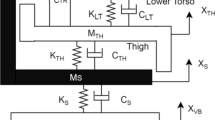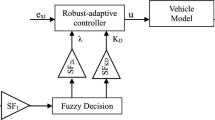Abstract
In the current car automobile industry, vehicle ride comfort is the most important design aspect due to its direct effect on the health and efficiency of human beings. The available literature on vehicle active suspension systems to improve vehicle performance (ride comfort, handling, road holding and suspension deflection, etc.) is somewhat sparse, and there is a major lack of research on seated driver biodynamic comfort analysis and enhancement. In this paper, a nonlinear full-car active suspension system with seated driver biodynamics [19 degrees of freedom (DoF)] model is presented. The effects of biodynamic vibrations on different parts of the driver’s body are examined. A NeuroFuzzy adaptive control paradigm is applied to the full-car active suspension system to damp the vehicle low-frequency vibrations, which can cause health problems and fatigue, resulting in fatal accidents. The effectiveness of the proposed control strategy to damp vehicle low-frequency and biodynamic vibrations is validated by comparing the performance with conventional (passive) and PID-controlled suspension systems.












Similar content being viewed by others
References
Hulshof C, van Zanten BV (1987) Whole-body vibration and low-back pain. Int Arch Occup Environ Health 59(3):205–220
Burdorf A, Sorock G (1997) Positive and negative evidence of risk factors for back disorders. Scand J Work Environ Health:243–256
A.L. Backman. (1983) Health survey of professional drivers.Scandinavian journal of work, environment and health 30-35
Tiemessen IJ, Hulshof CT, Fringsresen MH (2009) Effectiveness of an occupational health intervention program to reduce whole body vibration exposure: An evaluation study with a controlled pretestposttest design. Am J Ind Med 52(12):943–952
Gallagher S, Mayton AG (2007) Back injury control measures for manual lifting and seat design. Min Eng 59(12):41–49
Liang CC, Chiang CF (2006) A study on biodynamic models of seated human subjects exposed to vertical vibration. Int J Ind Ergon 36(10):869–890
Verver MM, De Lange R, van Hoof JF, Wismans JS (2005) Aspects of seat modelling for seating comfort analysis. Appl Ergon 36(1):33–42
Kim TH, Kim YT, Yoon YS (2005) Development of a biomechanical model of the human body in a sitting posture with vibration transmissibility in the vertical direction. Int J Ind Ergon 35(9):817–829
Paddan GS, Griffin MJ (2002) Evaluation of whole-body vibration in vehicles. J Sound Vib 253(1):195–213
Boileau P, Rakheja S (1998) Whole-body vertical biodynamic response characteristics of the seated vehicle driver: measurement and model development. Int J Ind Ergon 22(6):449–472
Wang W, Rakheja S, Boileau P (2004) Effects of sitting postures on biodynamic response of seated occupants under vertical vibration. Int J Ind Ergon 34(4):289–306
Qassem W (1996) Model prediction of vibration effects on human subject seated on various cushions. Med Eng Phys 18(5):350–358
Paddan GS, Griffin MJ (1998) A review of the transmission of translational seat vibration to the head. J Sound Vib 215(4):863–882
Paddan GS, Griffin MJ (2002) Effect of seating on exposures to whole-body vibration in vehicles. J Sound Vib 253(1):215–241
Hrovat Davor (1997) Survey of advanced suspension developments and related optimal control applications. Automatica 33(10):1781–1817
Els PS, Theron NJ, Uys PE, Thoresson MJ (2007) The ride comfort vs. handling compromise for off-road vehicles. J Terramech 44(4):303–317
Rahmi G (2003) Active control for seat vibrations of a vehicle model using various suspension alternatives. Turk J Eng Environ Sci 27:361–373
Yagiz N, Hacioglu Y (2008) Backstepping control of a vehicle with active suspensions. Control Eng Pract 16(12):1457–1467
OPREA RA, MIHAILESCU M (2011) Oscillations of the vehicles with dry friction damping. InSISOM 2011 and Session of the Commission of Acoustics
Alleyne A, Hedrick JK (1995) Nonlinear adaptive control of active suspensions. IEEE Trans Control Syst Technol 3(1):94–101
Zadeh LA (1965) Fuzzy sets. Inf Control 8(3):338–353
Yagiz N, Hacioglu Y, Taskin Y (2008) Fuzzy sliding-mode control of active suspensions. IEEE Trans Ind Electron 55(11):3883–3890
Li H, Yu J, Hilton C, Liu H (2013) Adaptive sliding-mode control for nonlinear active suspension vehicle systems using TS fuzzy approach. IEEE Trans Ind Electron 60(8):3328–3338
Eski I, Yldrm Ş (2009) Vibration control of vehicle active suspension system using a new robust neural network control system. Simul Model Pract Theory 17(5):778–793
Cao J, Liu H, Li P, Brown DJ (2008) State of the art in vehicle active suspension adaptive control systems based on intelligent methodologies. IEEE Trans Intell Transp Syst 9(3):392–405
Sun PY, Chen H (2003) Multiobjective output-feedback suspension control on a half-car model. InControl Applications, 2003. CCA 2003. In: Proceedings of 2003 IEEE conference, vol 1, pp 290–295
Kruczek A, Stribrsky A (2004) A full-car model for active suspension-some practical aspects. InMechatronics, 2004. ICM’04. In: Proceedings of the IEEE international conference, pp 41–45
Khan L, Qamar S, Khan MU (2014) Comparative analysis of adaptive NeuroFuzzy control techniques for full car active suspension system. Arab J Sci Eng 39(3):2045–2069
Dong XM, Yu M, Liao CR, Chen WM (2010) Comparative research on semi-active control strategies for magneto-rheological suspension. Nonlinear dyn 59(3):433–453
Du H, Li W, Zhang N (2012) Integrated seat and suspension control for a quarter car with driver model. IEEE Trans Veh Technol 61(9):3893–3908
Gudarzi M, Oveisi A (2014) Robust control for ride comfort improvement of an active suspension system considering uncertain driver’s biodynamics. J Low Freq Noise Vib Act Control 33(3):317–340
International organization for Standardization, Mechanical vibration and shock-evaluation of human exposure to whole body vibration-part general requirement, ISO2631-1 1997
Sekulić D, Dedović V, Rusov S, Šalinić S, Obradović A (2013) Analysis of vibration effects on the comfort of intercity bus users by oscillatory model with ten degrees of freedom. Appl Math Model 37(18):8629–8644
Sun W, Gao H, Kaynak O (2011) Finite frequency \(H_ { infty}\) control for vehicle active suspension systems. IEEE Trans Control Syst Technol 19(2):416–422
Zuo L, Nayfeh SA (2003) Low order continuous-time filters for approximation of the ISO 2631–1 human vibration sensitivity weightings. J Sound Vib 265(2):459–465
Gallais C (2008) Effect of vibration exposure duration on discomfort. PhD thesis, University of Southampton
Qassem W, Othman MO, Abdul-Majeed S (1994) The effects of vertical and horizontal vibrations on the human body. Med Eng Phys 16(2):151–161
Kukolj D (2002) Design of adaptive Takagi-Sugeno-Kang fuzzy models. Appl Soft Comput 2(2):89–103
Gupta MM, Qi J (1991) Theory of T-norms and fuzzy inference methods. Fuzzy Sets Syst 40(3):431–450
Liang CC, Chiang CF, Nguyen TG (2007) Biodynamic responses of seated pregnant subjects exposed to vertical vibrations in driving conditions. Veh Syst Dyn 45(11):1017–1049
Author information
Authors and Affiliations
Corresponding author
Additional information
Technical Editor: Kátia Lucchesi Cavalca Dedini.
Appendices
Appendix A
1.1 A.1 State vector
The state vector is defined as follows:
1.2 A.2 State matrices
The nonlinear deferential matrix, input matrix, dry friction matrix, and input excitation are as follows:
1.3 A.3 Vehicle parameters
1.4 A.4 Driver model parameters
1.5 A.5 Dry friction Parameters
1.6 A.6 Car chassis corners vertical displacement
Appendix B
1.1 B.1 Vertical displacement and ITAE comparison
1.2 B.2 Vertical weighted RMS acceleration and ITAE comparison
1.3 B.3 Suspension travel
1.4 B.4 Tire deflection
1.5 B.5 RMS vertical acceleration versus frequency
1.6 B.6 Tables
Rights and permissions
About this article
Cite this article
Riaz, S., Khan, L. Adaptive soft computing paradigm for a full-car active suspension system with driver biodynamic vibration damping control. J Braz. Soc. Mech. Sci. Eng. 39, 4305–4333 (2017). https://doi.org/10.1007/s40430-017-0827-4
Received:
Accepted:
Published:
Issue Date:
DOI: https://doi.org/10.1007/s40430-017-0827-4


















